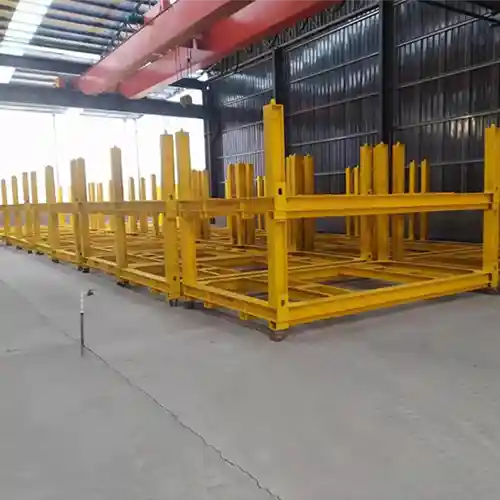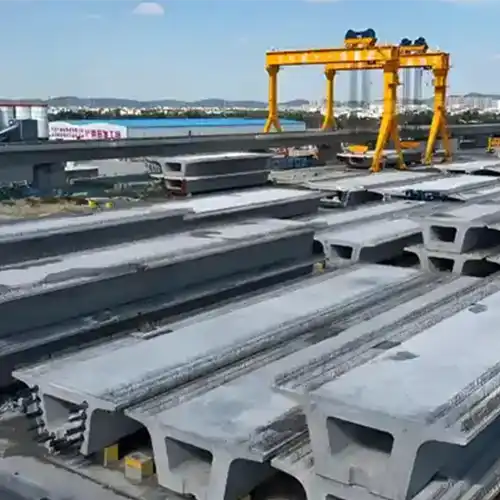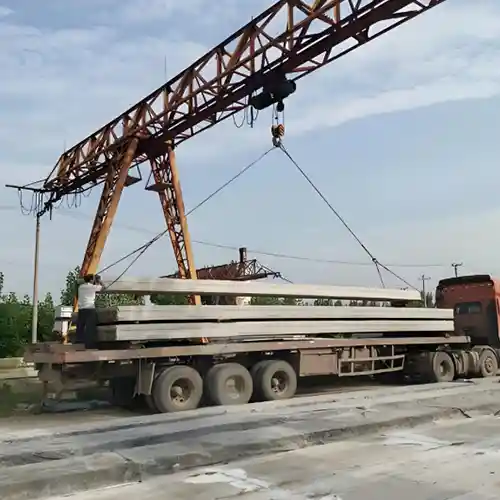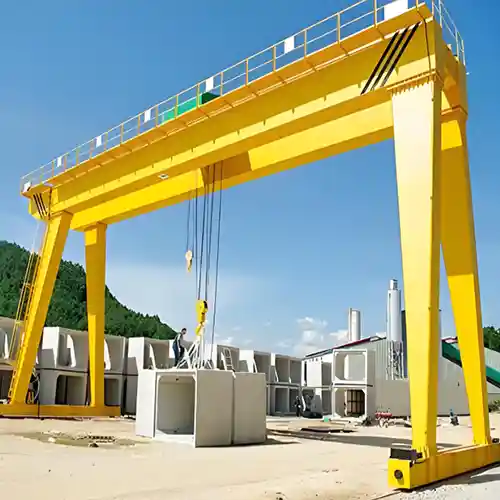Material Handling Overhead Cranes in Prefabrication Plants
Enhance efficiency and safety in prefabrication plants with overhead cranes for tooling, hangers, and rack systems.
Category: Construction
Your Trusted Overhead Crane Manufacturer & Supplier
Overhead Cranes for Tooling, Hangers, and Rack Systems in Prefabrication Plants

Critical Role of Overhead Cranes in Prefabrication Plants
Overview of Prefabrication Plants: The Need for Efficient Material Handling Systems
In prefabrication plants, large construction components like concrete panels, steel beams, and pre-cast elements are produced and stored before being transported to construction sites. The ability to handle these materials efficiently is crucial to ensure smooth production and timely delivery.
Key Challenges:
- Handling heavy and bulky materials.
- Storing components safely while optimizing space.
- Ensuring materials are transported with minimal risk of damage.
Overhead cranes play an essential role in solving these challenges by providing an efficient way to lift and move materials safely across the plant.
Challenges in Material Handling: The Complexity of Handling Large, Delicate, or Bulky Materials
Prefabrication plants deal with materials that are large, heavy, and often delicate, which can complicate handling processes. These materials can pose several key challenges:
- Heavy Materials: Components like steel beams and concrete panels are very heavy and require cranes with sufficient lifting capacity.
- Delicate Materials: Some prefabricated components, such as glass or thin panels, are fragile and must be handled gently to avoid breakage.
- Limited Space: Many prefabrication plants have constrained space, requiring cranes that can operate in tight areas.
- Time Sensitivity: The need to transport materials quickly and efficiently to avoid production delays.
These factors highlight the need for a reliable and safe material handling solution. Overhead cranes, with their precise lifting capabilities, offer a solution to these challenges.
Why Overhead Cranes Are Essential: Improving Safety, Efficiency, and Workflow
Overhead cranes are indispensable in addressing the complex material handling needs of prefabrication plants. They enhance safety, improve efficiency, and streamline workflow across various stages of production and storage.
- Improved Safety:Overhead cranes eliminate the need for manual lifting, reducing the risk of injury from handling heavy or awkward materials.Equipped with safety features like load sensors and emergency stops, cranes provide added protection for workers.
- Increased Efficiency:Cranes can move large or heavy materials quickly, reducing the time spent on manual handling or using less efficient machinery.Faster material movement leads to fewer production delays, improving overall plant efficiency.
- Optimized Workflow:Cranes ensure smooth transitions between production, storage, and shipping areas, preventing bottlenecks.They help maintain a continuous flow of materials, enabling the plant to meet tight production schedules.
In conclusion, overhead cranes are essential in prefabrication plants for improving safety, increasing efficiency, and maintaining a seamless workflow. By handling large, heavy, and delicate materials with precision, they ensure smooth operations and contribute to overall productivity.
Key Components of Overhead Crane Systems for Tooling, Hangers, and Rack Systems
Lattice Girder Stacking Racks
- Use: Lattice girder stacking racks are primarily used for storing and transporting prefabricated components such as beams, panels, and other structural elements. These racks are designed to handle large, heavy items with a focus on efficient storage and easy access for transport within the plant.
- Crane Capacity: Typically ranges from 1 to 10 tons for light to medium-duty operations. This range is suitable for handling the weight of most prefabricated beams and panels.
Benefits:
- Maximizes Storage Efficiency: The design of the lattice girder racks allows for optimal use of vertical space, ensuring that components can be stored safely while minimizing the footprint required.
- Protects Components: By securely holding materials in place, these racks prevent damage during transportation and movement, preserving the integrity of sensitive prefabricated components.
- Space Optimization: Ideal for maximizing storage in limited space, allowing prefabricated components to be organized and readily accessible for future use.
Wall Board Stacking and Transporting Racks
- Use: These racks are specifically designed to handle delicate wall boards and partitions, which are common in prefabricated construction. The racks ensure that these fragile materials are stored and moved safely without risking breakage or damage.
- Crane Capacity: Typically ranges from 5 to 20 tons, depending on the size and weight of the wall boards and racks. Larger or more complex setups may require higher capacities.

Benefits:
- Safe and Efficient Transport: The racks are designed to keep the wall boards securely in place during lifting and transport, reducing the risk of accidents or material damage.
- Minimizes Damage to Fragile Products: The gentle handling and secure positioning of the wall boards ensure they are moved with minimal impact, preserving their quality and integrity.
- Improved Handling: With the right crane and rack system, the process of loading, storing, and transporting wall boards becomes faster and more efficient, minimizing handling time.
Lifting Tooling
- Use: Lifting tooling is a specialized set of tools used for handling heavy or complex components that require precision lifting, such as custom molds, machinery parts, or large prefabricated structures. These tools are designed for specific lifting tasks and are crucial for handling awkward or uniquely shaped materials.
- Crane Capacity: Typically ranges from 10 to 50 tons, with higher capacities needed for larger or more specialized tooling systems.
Benefits:
- Precision Handling: These tools enhance the accuracy of lifts, allowing for careful movement of large or awkwardly shaped equipment and components.
- Increased Safety: By using the right tooling, the crane system reduces the chances of tipping or damaging heavy components during handling.
- Versatility in Handling: Lifting tooling can be adapted for different tasks, offering flexibility for a wide range of lifting needs in prefabrication operations.
Steel Bar Stacking Racks
- Use: Steel bar stacking racks are used to store and transport heavy steel bars and reinforcement materials commonly found in prefabrication plants. These racks ensure that steel bars are organized and easy to access for further use or shipment.
- Crane Capacity: Typically ranges from 10 to 30 tons for standard steel bar handling. Larger or more complex steel bar systems may require cranes with higher capacities.
Benefits:
- Organized Storage: Steel bars are kept neatly stacked and easily accessible, reducing clutter and improving organization within the plant.
- Quick and Efficient Transportation: The racks allow for fast movement of steel bars between storage and processing areas, reducing time spent on handling and increasing overall plant efficiency.
- Prevents Material Damage: Properly secured steel bars reduce the risk of bending or damaging materials during transport, ensuring they are ready for the next phase of production.
In summary, overhead crane systems for tooling, hangers, and rack systems in prefabrication plants play a crucial role in efficiently managing and moving heavy, delicate, or bulky materials. The use of specific crane capacities tailored to the needs of each component ensures that the lifting and transport processes are safe, efficient, and minimize the risk of damage to valuable materials.

electric material handling crane for racking handling

overhead cranes and gantry cranes for different tooling, hangers and rack handling
Crane Capacity and Typical Applications for Tooling, Hangers, and Rack Systems
Light Duty Cranes (Up to 5 Tons)
Applications: Light duty cranes are typically used for lifting small to medium-sized components such as lightweight tools, hangers, or small storage racks. They are ideal for handling materials that are not heavy but require precision and careful handling.
Common Capacities:1 ton,2 tons,3 tons,5 tons,
Typical Use Cases:
- Workshops and Smaller Prefabrication Plants: In smaller facilities, these cranes efficiently handle lightweight tools, racks, and other components.
- Lightweight Materials: Ideal for storing and moving small prefabricated parts like brackets, light panels, or smaller hangers.
- Custom Lifting: Used for handling specialized, lightweight equipment or tools in manufacturing environments.
Medium Duty Cranes (5 to 20 Tons)
Applications: Medium duty cranes are designed for lifting heavier components, such as large racks, pre-cast concrete panels, and medium-sized lifting tools. These cranes are well-suited for operations requiring a balance between lifting power and flexibility.
Common Capacities:10 tons,15 tons,20 tons,
Typical Use Cases:
- Medium-Sized Prefabrication Plants: Perfect for handling medium-weight materials and components in plants with higher production volumes.
- Lifting Tools and Pre-Cast Components: These cranes handle larger tooling systems, pre-cast concrete elements, and racks designed to store or transport larger items.
- Transporting Large Materials: Often used for moving medium-sized structural elements, such as beams or wall panels.
Heavy Duty Cranes (Above 20 Tons)
Applications: Heavy duty cranes are used to handle the largest, heaviest components in prefabrication plants. These cranes are essential for transporting steel beams, concrete panels, and large storage racks designed for heavy-duty materials.
Common Capacities:25 tons,30 tons,50 tons (or more)
Typical Use Cases:
- Large Prefabrication Plants: Used in larger facilities where the materials are more substantial and need powerful lifting capabilities.
- Steel and Concrete Components: Ideal for transporting heavy steel reinforcement bars, large concrete panels, and other oversized elements.
- Heavy-Duty Racking Systems: Used for lifting and moving heavy-duty racks that store large or bulky components like beams and steel bars.
Specialized Heavy Duty Cranes (Above 50 Tons)
Applications: Specialized cranes are custom-built to handle extremely heavy, oversized components or complex tooling systems. These cranes are tailored to specific lifting needs in industries that require high precision and very large capacities.
Common Capacities:50 tons,100 tons,200 tons (or higher, depending on requirements)
Typical Use Cases:
- Aerospace and Large-Scale Manufacturing: Common in industries that handle large or heavy custom components, such as aerospace or shipbuilding.
- Large-Scale Prefabrication Plants: Ideal for plants producing massive components or requiring custom lifting solutions for oversized machinery and materials.
- Custom Lifting Solutions: Often used for specific lifting tasks that involve oversized materials or complex, heavy tooling.
In summary, the selection of crane capacity is critical for the efficient handling of materials in prefabrication plants. Light duty cranes (1–5 tons) are suited for smaller components and tools. Medium duty cranes (5–20 tons) are used for larger materials like pre-cast panels and racks. Heavy duty cranes (above 20 tons) are essential for large beams and concrete components. Finally, specialized heavy duty cranes (50 tons and above) are tailored for handling oversized, complex materials and custom lifting tasks.
Key Benefits of Using Overhead Cranes for Tooling, Hangers, and Racks
Increased Storage Capacity
- Vertical Transport: Overhead cranes are essential for maximizing the use of available space in prefabrication plants. By lifting materials vertically, they free up valuable floor space that can be used for other operations or to store additional components.
- Space Optimization: With the ability to stack materials or transport them to elevated storage areas, cranes allow for more efficient storage solutions and a more organized workspace, which is crucial in high-demand production environments.
Protection of Materials
- Minimized Risk of Damage: Specialized cranes and lifting tools are designed to ensure safe handling of materials, especially delicate or oversized items. By using custom-designed lifting slings, hooks, and attachments, cranes can move fragile components like wall boards or heavy tooling without risking damage.
- Secure Handling: Overhead cranes enable precise control over material movement, which reduces the chance of dropping or mishandling sensitive products. This is particularly important for delicate items like pre-cast panels or intricate machinery parts that can be easily damaged during transport.
Improved Efficiency
- Faster Material Movement: Overhead cranes significantly reduce the time required for material handling compared to manual lifting or the use of forklifts. This acceleration of material transport speeds up production processes, allowing for faster cycle times and more efficient operations.
- Streamlined Production and Delivery: With cranes, materials are easily and quickly moved from storage areas to production lines or loading zones. This enhances overall workflow efficiency, enabling quicker turnaround times and meeting tight delivery deadlines.
Enhanced Worker Safety
- Reduced Manual Labor: Overhead cranes eliminate the need for workers to manually lift or move heavy, awkward, or bulky items, thereby reducing the risk of workplace injuries such as strains, sprains, or crush injuries.
- Safer Work Environment: By automating material handling tasks, cranes minimize human interaction with heavy loads, significantly decreasing the likelihood of accidents involving equipment or materials. This contributes to a safer overall work environment.
Custom Solutions
- Tailored Crane Designs: Overhead cranes can be customized to meet the specific needs of a prefabrication plant, ensuring that lifting tools, hangers, and rack systems are designed to fit the exact requirements of the production process.
- Bespoke Lifting Equipment: Whether it’s a custom tool to handle specialized components or a unique rack system for storing large or delicate materials, cranes can be tailored to handle specific materials and workflows, improving both safety and efficiency.
In conclusion, overhead cranes offer a range of benefits that enhance the overall operations of prefabrication plants. From maximizing storage capacity and ensuring the protection of materials to improving efficiency, worker safety, and offering custom solutions, overhead cranes are integral to the smooth functioning of modern prefabrication operations.
Advanced Features and Technology in Overhead Cranes
Safety Features
- Load Sensors: Advanced load sensors are integrated into overhead cranes to continuously monitor the weight being lifted. These sensors ensure that the crane operates within its rated capacity, preventing overloads and minimizing the risk of crane failure during operations.
- Anti-Collision Systems: Anti-collision technology helps prevent accidents between the crane and other machinery, structures, or workers. These systems use proximity sensors or cameras to detect potential collisions, stopping the crane automatically or alerting operators to take corrective action.
- Emergency Stops: Overhead cranes are equipped with emergency stop buttons and automatic shutdown features to immediately halt operations in the event of an emergency. This enhances safety by allowing operators to quickly respond to unforeseen situations, minimizing the risk of injury or equipment damage.
- Overload Protection: Overload protection systems are designed to stop the crane’s operation if it detects that the load exceeds the crane's capacity. This ensures that both the crane and the load are not subjected to undue stress, safeguarding the entire operation.
Automation and Integration
- Automated Operations: Many modern overhead cranes are equipped with automation systems that allow them to operate without direct human intervention. These systems can be programmed to carry out specific tasks, such as transporting materials from one part of the plant to another, without requiring manual control.
- Integration with Automated Production Lines: Overhead cranes can be seamlessly integrated into automated production lines. This allows for real-time synchronization between the crane's operations and other automated processes, improving workflow, reducing human error, and enhancing overall productivity.
- Smart Control Systems: Modern overhead cranes are equipped with advanced control systems that provide operators with real-time data, such as load weight, crane speed, and operational status. This data is accessible through touchscreens or mobile devices, allowing for more precise control and greater insight into crane performance.
- Remote Control and Monitoring: Many overhead cranes can be operated remotely, allowing for greater flexibility and safety. Operators can control the crane from a distance, reducing the risk of injury in hazardous areas and ensuring more precise operations, especially in complex environments.
Durability and Maintenance
- High-Quality Materials: Overhead cranes are built using high-quality steel and other robust materials that are designed to withstand heavy loads, harsh environments, and frequent use. This ensures long-term durability and the ability to handle the rigors of industrial applications.
- Robust Design: The design of modern cranes focuses on strength and reliability, ensuring that they can operate under demanding conditions. Components such as the hoist mechanism, trolley, and rails are engineered for heavy-duty use, offering superior performance and longevity.
- Reduced Maintenance Needs: With the use of durable materials and advanced technology, modern overhead cranes require less maintenance than older models. Routine maintenance tasks are simplified, and preventive systems like self-lubricating bearings and diagnostic tools reduce downtime by detecting potential issues before they become critical.
- Long-Term Reliability: The combination of durable materials, advanced design, and ongoing technological advancements means that overhead cranes can perform consistently over extended periods, offering excellent return on investment for businesses. By reducing the frequency and cost of maintenance, companies can ensure uninterrupted operations in demanding industrial environments.
In conclusion, the advanced features and technology in overhead cranes contribute significantly to their efficiency, safety, and reliability. From integrated safety systems and automation capabilities to durable construction and minimal maintenance needs, modern overhead cranes are essential tools for enhancing productivity and ensuring long-term operational success in prefabrication plants and other industrial environments.
Case Studies: Real-World Applications of Overhead Cranes in Prefabrication Plants
Prefab Concrete Panels
- Challenge: In a prefabrication plant specializing in concrete panel production, handling large, heavy panels manually or with forklifts often led to significant material damage and increased labor costs. The risk of breakage and inefficient storage resulted in slower production timelines.
- Solution: The plant installed overhead cranes with specialized lifting tools designed to handle large concrete panels. These cranes were equipped with custom hooks and slings to securely lift and transport the panels without causing stress on the material.
Results:
- Increased Efficiency: The use of overhead cranes dramatically reduced the time spent on moving and positioning each panel.
- Reduced Material Damage: The cranes allowed for smoother, more controlled movements, reducing the risk of panel breakage during handling.
- Improved Storage: The ability to stack panels vertically optimized storage space and allowed for more efficient use of floor area.
- Enhanced Safety: The cranes minimized the need for manual lifting, reducing the risk of injuries from moving heavy, unwieldy panels.
Steel Beam Handling
- Challenge: Steel beams, essential for the structure of buildings and other large projects, are heavy and difficult to maneuver. In a prefabrication plant focused on steel fabrication, moving large beams manually was both time-consuming and dangerous, leading to inefficiencies and worker injuries.
- Solution: Overhead cranes were introduced to handle the steel beams, with hoists designed to accommodate heavy loads. The cranes were configured to lift, transport, and position the beams with precision, while specialized lifting attachments ensured safe and secure handling.
Results:
- Improved Safety: Overhead cranes significantly reduced the risk of injuries caused by lifting heavy steel beams manually.
- Higher Throughput: With the ability to move multiple beams at once, production timelines were shortened, and the overall output of the plant increased.
- Precision Handling: The cranes allowed for more accurate placement of beams, reducing errors in the assembly and fabrication process.
- Space Utilization: The cranes’ ability to transport materials vertically allowed for better storage organization, freeing up floor space for other processes.
Custom Racking Systems
- Challenge: A prefabrication plant specializing in manufacturing large, delicate components required a solution for storing and transporting oversized items without risking damage. The challenge was designing a system that could handle both heavy-duty materials and fragile components efficiently.
- Solution: The plant worked with crane manufacturers to design custom racking systems integrated with overhead cranes. These systems included adjustable racks that could hold both heavy materials, like steel beams, and delicate items, like glass panels, without causing damage during handling or transport.
Results:
- Tailored Storage Solutions: The custom racks allowed for flexible storage options for materials of varying sizes and weights, improving organization.
- Safe Transport: The cranes, equipped with custom lifting tools and rigging, ensured that delicate and heavy materials were safely moved without risk of damage.
- Optimized Workflow: The racking systems, combined with overhead cranes, streamlined the material handling process, reducing delays between production stages and improving workflow efficiency.
- Cost Savings: By reducing material damage and improving handling speed, the plant saved on repair costs and minimized downtime, ultimately increasing overall profitability.
In conclusion, these case studies demonstrate the significant impact overhead cranes can have in prefabrication plants, improving efficiency, safety, and material handling. Whether for handling large concrete panels, steel beams, or custom racking systems, overhead cranes provide the necessary solutions to optimize production and storage, while minimizing risks and costs.
Customization for Specific Plant Needs
Tailored Solutions for Diverse Products
- Custom Crane and Racking Designs: In prefabrication plants, the need for specific lifting and storage solutions is paramount due to the wide variety of materials handled. Cranes and racking systems can be customized to handle different components, from heavy steel beams to fragile concrete panels. This customization ensures that every item, regardless of its size, shape, or weight, is moved and stored safely and efficiently.
- Adapting to Material Types: Whether it's delicate wall boards, large steel bars, or oversized prefab concrete panels, cranes can be fitted with specialized attachments and hoisting equipment. For example, adjustable lifting hooks, slings, and spreader bars allow the crane to adapt to various load types, ensuring proper handling without damage. This flexibility makes overhead cranes a versatile tool in a variety of industries, including construction, aerospace, and manufacturing.
- Custom Racking Systems: In addition to cranes, racking systems can also be tailored to meet the specific needs of a plant. For instance, adjustable racks for storing steel bars, concrete panels, or fabricated components ensure that materials are organized and accessible, while minimizing the risk of material damage. These custom racks can also be integrated with overhead cranes to automate material handling and improve workflow efficiency.
Space Optimization
- Maximizing Vertical Storage: One of the key benefits of overhead cranes is their ability to utilize vertical space, allowing for more efficient storage in plants where floor space is limited. By transporting materials to elevated storage areas or stacking them higher, overhead cranes free up valuable ground space that can be used for other operations, such as assembly, production, or additional storage.
- Optimizing Workflow and Movement: In busy prefabrication plants, overhead cranes can be strategically positioned to facilitate smooth movement of materials throughout the facility. By minimizing the need for forklifts or manual handling, cranes reduce congestion and improve traffic flow, ensuring that materials are delivered to the right location at the right time without unnecessary delays. This streamlined movement not only saves time but also reduces the risk of accidents in high-traffic areas.
- Flexible Layouts: Overhead cranes can be integrated into custom plant layouts, with tracks and hoists positioned to cover the most critical work areas. The cranes can also be designed to move across the entire plant, allowing workers to access materials at various locations without wasting time or effort. This flexibility in crane design and positioning is crucial for optimizing space and improving the overall efficiency of operations.
In conclusion, the customization of overhead cranes and racking systems plays a pivotal role in enhancing the efficiency and safety of prefabrication plants. Tailored solutions ensure that diverse products, from delicate items to heavy materials, are handled with care, while space optimization through vertical storage and streamlined workflows helps create more efficient, organized, and productive plant environments.
Conclusion: The Importance of Overhead Cranes in Optimizing Material Handling
Overhead cranes play a vital role in optimizing material handling in prefabrication plants. Their ability to handle heavy, bulky, and delicate materials with precision offers several key benefits:
- Improved Efficiency: By automating material movement, overhead cranes significantly reduce manual labor, speeding up production timelines and improving overall workflow.
- Enhanced Safety: Cranes eliminate the need for workers to manually lift heavy or awkwardly shaped components, reducing the risk of workplace injuries.
- Maximized Storage Capacity: The ability to lift materials vertically allows for better space utilization, freeing up valuable floor area for other operations.
- Protection of Materials: Custom lifting tools and hoists ensure that materials are handled with care, minimizing the risk of damage during storage and transportation.
- Customization and Flexibility: Cranes can be tailored to meet the specific needs of a plant, whether it’s handling specialized tooling, custom racks, or large prefab components.
In sum, overhead cranes are a critical asset to prefabrication plants, enhancing productivity, improving safety, and optimizing material handling and storage processes.
Related Products
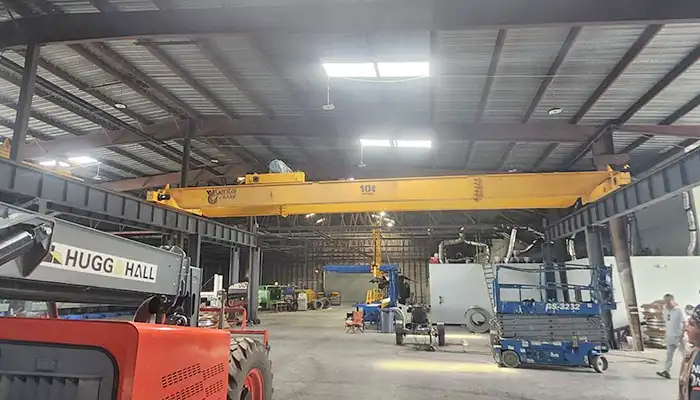
Affordable 10 ton double girder overhead crane with CD/MD hoist trolley, built for U.S. standards, ideal for construction and industrial lifting
Free consultation to Confirm Parameters & Specifications and Get
Latest Crane Price & Crane Rate.
- Types of overhead cranes : _______?
- Optional: Overhead travelling crane, goliath gantry crane,Slewing jib crane, Single girder or double girder crane,small portable crane or kbk crane, etc.
- Capacity of overhead crane: _______?
- Optional: 0.25ton, 0.5 ton, 1 ton, 2 ton, 3ton, 5 ton, 10 ton,15ton, 20ton, 25 ton, 30ton,35ton, up to 550ton, etc.
- Crane span & lifting height : _______?
- Crane travelling length : _____?
- Control of overhead crane:_______?
- Optional: pendant/ remote/cabin control
- Voltage supply of overhead crane:_____?
- Eg,: 380V50/60HZ,3Phase or others,etc.
- Application/usage of crane:_______?
- Eg,: Steel mill, ,injection mold, cement,stone, concrete,granite, general manufacturing, etc.
Just leave a message via the contact form and our hoist and crane engineer will contact you with in 24working hours.
Get In Touch
